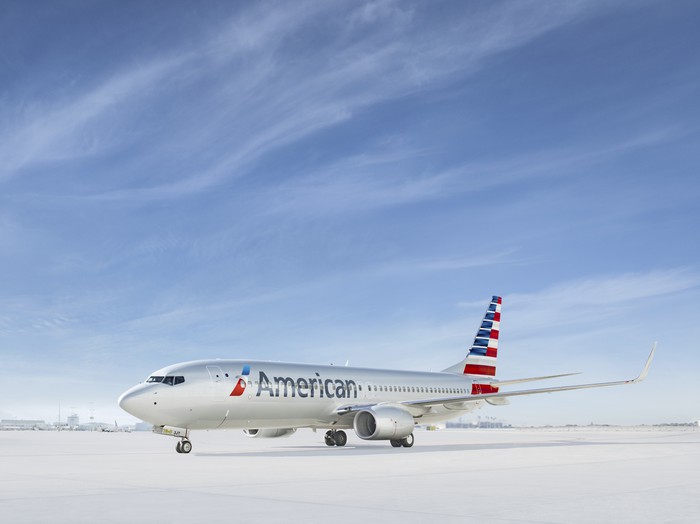
Source: American Airlines Group.
Last year saw record profits across the airline industry, and 2015 forecasts expect even more growth, much of it resulting from a significant decline in fuel prices.
As one of the few airlines that didn't hedge fuel prices, American Airlines Group (AAL +0.17%) may be the best positioned airline for this low-fuel-price environment. But with the dividend sitting at less than 1%, many investors are wondering whether this airline will return more cash to shareholders.
I expect any dividend increase at this airline to be small, if it happens at all, but I still believe the stock could be a good investment. Here's why.
Updated savings
During its fourth-quarter earnings announcement, American Airlines Group said it expected to save $5 billion from the decline in fuel prices. However, jet fuel prices have risen since the forecast was made (from about $1.50 per gallon then, to $1.73 now), and it's worth looking at how these changes may have affected the savings.

Source: American Airlines Group
American Airlines Group estimated fuel usage of approximately 4.3 billion gallons for 2015 in its 10-K, so this increase would be expected to cost the airline about $990 million if it stayed in place for the full year.
Of course, jet fuel is likely to remain volatile and even top energy analysts can't agree on where oil prices are headed next.
But the point of this example is that with American Airlines being completely unhedged, it's exposed to jet fuel volatility for better or worse. This reality makes it difficult for the airline to raise the dividend significantly and be confident that there will be the cash flow to back it.
At current levels, analyst forecasts are calling for around $10 per share in earnings for 2015; nearly double the $5.70 per share in adjusted earnings posted for 2014. If fuel prices remain low, these higher earnings could provide a boost to the airline's efforts described below.
Better opportunities
Although current fuel prices have positioned American Airlines for a far more profitable 2015, there are other major areas in which the airline needs to spend money besides dividends for shareholders.
One of the key areas is debt reduction, since American carries a net debt load of $10.9 billion, more than the $7.7 billion at United Continental Holdings (UAL +2.88%) and the $6.5 billion at Delta Air Lines (DAL +1.16%). It also carries a higher net debt-to-operating cash flow ratio of 3.5, compared with 3.0 at United and 1.3 at Delta.
While the debt load isn't threatening insolvency (in fact, American recently received an upgrade from Moody's), it could be depressing the airline's valuation by making it appear riskier than its peers. By using some of its fuel savings to reduce existing debt or pay for new aircraft upfront, American could begin tackling this debt load, possibly helping its valuation.

Source: American Airlines Group.
The airline is also undergoing a massive overhaul of its fleet, with the goals of reducing per-passenger fuel consumption, decreasing maintenance costs, and increasing passenger comfort. American has noted that some of its fuel savings will be spent on acquiring new aircraft to move this process along faster, and Forbes quoted American Airlines Group CEO Doug Parker as saying, "It is definitely in our shareholders' interest to invest."
Peer pressure?
Sometimes companies must raise their dividends to retain yields competitive with their peers. The idea is to attract more income investors to your own company's stock by making it stack up better against your rivals.
But while some foreign airlines pay dividends of over 2%, U.S.-based airlines, which form American Airlines' closest competition for investment dollars, all pay either small dividends or none.
Delta Air Lines pays a 0.79% dividend, and Southwest Airlines (LUV 0.04%) pays 0.54%. Alaska Air Group (ALK +1.48%), parent company of Alaska Airlines, pays a slightly larger 1.2% dividend, and United Continental pays no dividend at all.
At this point, American Airlines Group is already near the high-end of the dividend yield range among its peers, so there's little need to raise the dividend to measure up to its rivals.
Share buybacks
While American has stayed away from a dividend increase since it brought back its dividend last year, the airline has moved aggressively to buy back its own shares finishing a $1 billion buyback and starting a $2 billion buyback.

Source: American Airlines Group.
For a company in a volatile industry and closely exposed to jet fuel prices, a share buyback has a few advantages. First, the airline can turn it on or off without raising red flags as if a dividend was cut. This situation gives American Airlines more flexibility to expand or taper its share repurchases depending on industry conditions and jet fuel costs.
Second, buying back shares reduces the amount of dividends American needs to pay. If the $2 billion share buyback were executed at today's prices, it would save the airline roughly $16 million in annual dividends.
And finally, American Airlines Group's shares trade at a low valuation, even compared with its peers. Using data from 4-Traders.com, American trades at only 4.9 times estimated 2015 earnings, while Delta trades at 9.6 and United Continental trades at 6.3. Even if American's larger net debt justifies this discount, if other profits are directed to manage it, the valuation gap should close and the the share buyback will have been executed at good prices.
The bottom line
American Airlines Group is one of the biggest beneficiaries of lower oil and jet fuel prices; however, I don't expect big dividend increases from this airline in the near term. This airline still has to deal with a volatile commodity in a volatile industry, and there are better areas to use the profits, many of which American is already taking advantage of.
While I don't see a big dividend boost on the horizon for this airline, I still remain bullish because of its current execution and rock-bottom valuation.






